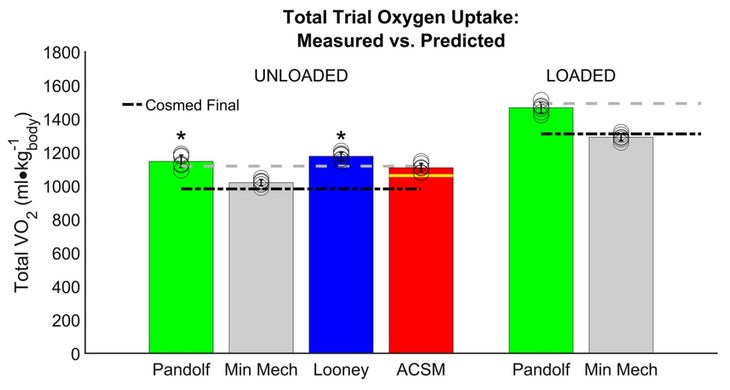Back in 2018, I wrote an optimistically titled article, “The Ultimate Backpacking Calorie Estimator,” based on a tool called the Pandolf equation that U.S. Army researchers developed back in the 1970s. You plug in your weight, the weight of your pack, your walking speed, and the gradient you’re climbing, and the equation (or the handy calculator I included in the article) spits out how many calories you’re burning per hour. There was just one problem with that original equation: it couldn’t handle downhill slopes. In fact, at a gradient of around negative ten percent, it predicted that you’d start creating energy instead of burning it.
I tried again a year later, when another team of researchers from the U.S. Army Research Institute of Environmental Medicine (USARIEM), led by David Looney, produced a modified equation that can handle both uphills and downhills. This equation, however, doesn’t allow you to plug in the weight of the load you’re carrying.
In practice, we want an equation that can handle hills and backpacks—and, more importantly, we want to be sure that its predictions are as accurate out in the real world as they are in the lab. When you’re planning a backpacking trip, you don’t want to run short of food, but you also don’t want to lug around a bunch of superfluous provisions that you’ll end up hauling right back out again. Understanding how hills and mud and pack weight and hiking speed affect your energy needs is a big step up from just assuming that you’ll be pretty hungry. To that end, Peter Weyand of Southern Methodist University, along with his colleagues Lindsay Ludlow and Jennifer Nollkamper and USARIEM’s Mark Buller, a head-to-head comparison of four walking calorie equations in the Journal of Applied Physiology. There’s the Pandolf and Looney equations from my previous articles (they use an updated version of the Pandolf equation that can handle downhills); there’s a very simple estimation from the American College of Sports Medicine; and there’s a super-equation that can handle both hills and backpacks that Weyand and Ludlow back in 2017, which they dubbed Minimum Mechanics.
The primary goal of the paper isn’t to pick the best equation. Instead, they’re testing the basic premise that it’s possible to make useful and accurate predictions of calorie cost in rugged real-world conditions from equations developed on a treadmill. The four equations can be modified with a terrain variable that adjusts the calories predictions if you’re walking on gravel or mud or whatever else you encounter outside the lab. But over the course of a long hike over hilly terrain and varying surfaces, can the equations really produce a decent prediction?
To find out, Weyand and his colleagues sent seven volunteers out for a four-mile hike up and down Dallas’s Flag Pole Hill Park, wearing a GPS, a heart-rate monitor, and a portable calorimeter to measure how much oxygen and carbon dioxide they breathed in and out. This is the crucial advance that wasn’t practical for researchers back in the 1970s: metabolic measurements out in the wild. The researchers also ran a series of other experiments to check the accuracy of their in-the-field calorie estimates and terrain adjustment factors. For the two equations equipped to handle backpacks, Pandolf and Minimum Mechanics, subjects repeated the field trial wearing a backpack holding 30 percent of their body weight.
The overall result can be summed up as “Yes, but…” The equations all did a reasonable job of estimating caloric burn over various gradients and terrains. Here’s the total energy consumption during the hikes (expressed as how much oxygen they breathed rather than how many calories burned), with the measured value shown as a dashed horizontal line:

You can see that, in this study by Weyand and Ludlow, the equation previously proposed by Weyand and Ludlow comes out looking best. With no backpack, it was four percent off, compared to 13, 17, and 20 percent off for the ACSM, Pandolf, and Looney equations. With a backpack, the Minimum Mechanics prediction was just two percent off, compared to 13 percent for Pandolf. That’s pretty good.
Still, it’s hard to make a final pronouncement on which equation is “right,” because different models may work best in different circumstances. One may be better at slow speeds, another may work best on uphills, another may excel with heavy loads. For example, take a closer look at the real-time estimates of calorie consumption by the four equations during the hike. The vertical axis shows oxygen consumption (ml/kg/min), which is proportional to the rate of calorie burning; the horizontal axis shows elapsed time during the hike.

During the first part of the hike, on level ground, the Looney equation has the highest estimate. On all the uphills (shaded red), the Pandolf equation gives the highest values. On the downhills (shaded blue), the ACSM equation leaps from the bottom to the top.
Weyand and his colleagues dig some of these nuances in the new paper, but most of us just want a simple estimate that’s good enough for practical estimates of caloric demand. Based on this particular data, the Minimum Mechanics model looks like the best bet. It was originally derived by testing 32 subjects under 90 different combinations of speed, grade, and load—a far cry from the three subjects used for the original ACSM equation and the six subjects used for the Pandolf.
In a perfect world, an app or website would input a GPS track and apply the equation to each successive point so that you could estimate calories needs for long and complex routes. (If anyone feels moved to code one, let me know and I’ll update this post!) For rough estimates of segments with a consistent grade, here are two Minimum Mechanics calculators for and walking. The is 1 for asphalt, and slightly higher for rougher terrains (e.g. 1.08 for asphalt, 1.2 for gravel roads); the grade is in percent, from -100 to +100. Happy trails!
For more Sweat Science, join me on and , sign up for the , and check out my book .


